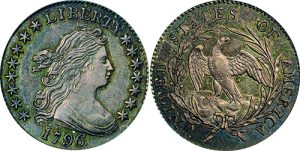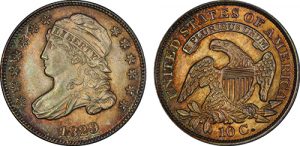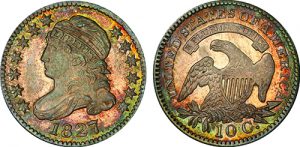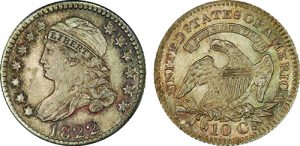
By Barry Sunshine and Charles Link
The Bust dime series is one of the most under-appreciated of all United States series. Bust dimes are available in sufficient quantity to satisfy every collector, no matter what their collecting styles, habits, or budgets. As active collectors of Bust dimes, we take pride in sharing the enjoyment that we have collecting and studying this fascinating series.
We are longtime collectors of U.S. coins and enjoy many types of coins. Our enjoyment goes beyond acquiring coins for the hunt. Most collectors enjoy that hunt, but stop there, as coin collecting is primarily a project mentality. We go further than that because coins tell stories. We look at coins and ask ourselves: “If coins could talk, what stories would they tell?” Having said that, coins are not able to talk. But we are able to talk. So we feel it’s our responsibility to tell the stories on behalf of our coins. Telling these stories is gratifying and serves as a source of great enjoyment.
The Story Behind Bust Dimes

Bust dimes are awe-inspiring because they represent so many stories. So the work and research doesn’t stop. If it wasn’t for our demanding day jobs, more research would be done.
Bust dimes were first minted by the U.S. Mint in 1796, and that first obverse was used from 1796 until 1807. This first type is referred to as the Draped Bust dime. Even though that obverse remained the same throughout the Draped Bust dime series, the reverse was changed in 1798. The reverses for the 1796 and 1797 dimes bear a Small Eagle, and in 1798, the reverse was changed to the Heraldic Eagle that was used until 1807. It is interesting to note that neither the denomination nomenclature of “10 CENTS” nor “DIME” were used on the dime to denote its value, and it is not fully known why the Mint did that.
A little-known fact about Draped Bust dimes is that the Mint used the same Heraldic dies to mint both Draped Bust dimes and Quarter Eagle gold coins. One of the primary reasons why the Mint used the dies for both coinage types was the amount of work necessary to engrave each die.
After 1807, the Mint resumed dime production in 1809 with a new design referred to as the Capped Bust.
Capped Bust dimes were minted from 1809 until 1837. In 1828, the Mint produced dimes with a “closed collar” manufacturing design. Prior to using that process, the Mint produced dimes using the open collar. The difference in appearance between these two different processes gives the impression that the earlier dimes are larger than the later Capped Bust dimes.
Approaches to Collecting
There are many ways to collect early dimes. The most basic way is to put together a type set of early dimes. A simple type set can include two coins – a Draped Bust and Capped Bust dime. If you want to expand your type set, you can add two more coins by adding the two types of Draped Bust dimes with the Small Eagle (1796 or 1797) and the Heraldic Eagle reverse (1798 to 1807) and two Capped Bust dimes –Large Size (1809 to 1828) and Reduced Size (1828 to 1837).

Collectors with a greater interest can assemble a collection based on a date set, “Red Book (A Guide Book of U.S. Coins)” set or collect all die marriages. The various die marriages were created by using different combinations of obverse and reverse dies in producing the coins. Collecting early dimes by die marriage is a quest that requires collectors to be dedicated and passionate about their collections.
While both series have their key dates, the Draped Bust series has many extremely rare dates. The key date is the 1804 dime, as its reported mintage is a mere 8,265. We contend that only 110 are known to have survived today, with only one known Mint State example. While other dimes are not considered key dates, 1798 to 1803 dated dimes are considered as semi-keys and very desirable to collectors.
In the Capped Bust dime series, the 1822 is considered the key date, with 50,000 minted and only about 250 that are extant or known to survive. The semi-key dates are 1809 and 1811/9. With patience, you can locate all of these.
Patience Is the Path
While assembling a collection of Bust dimes takes a fair amount of patience. Link contends that a good many early dimes are cleaned and damaged, and recommends avoiding those in favor of originally toned examples. Those originally-toned, problem-free coins have the greatest potential to appreciate in value.

Each collector’s approach is different in his or her collecting views. We originally started collecting Capped Bust dimes in About Uncirculated condition, and then upgraded our collection over time. We each are pursuing a Capped Bust dime set with all die marriages. Original, pristine coins and varieties that are part of sets are those that we most enjoy owning. To accomplish our goals, it requires a lot of patience. We agree that Sunshine has more patience than Link, but we enjoy how we acquire our coins. Sunshine prefers waiting for a particular look of a coin, while Link prefers finding a very nice example and later upgrading it when a more special coin is located. However, when a “wow” coin appears, our interest is captured immediately, as we enjoy originally toned coins that look sensational.
Even though we acquire our coins for enjoyment, we realize that coins are an investment. There are no ultimate consumers of coins, and we are the keepers of our coins for the next generation. We prefer the coins that are spectacular and that others will enjoy owning in future years. This is where the investment side comes in. Link says that that the potential profit side of coins starts not when you decide to sell, but when you acquire the coin. Sunshine agrees with Link’s approach and notes that most collectors don’t realize the investment side starts at the time of purchase.
When selecting coins, we prefer coins with landmark pedigrees, as it adds value to each collection.
Early Dimes in Famous Collections

Over the years, there have been many famous collectors of early dimes, and these collectors include some of the most important names in numismatics: Eliasberg, Norweb, Pittman, and Garrett. More recent names include Gardner and Pogue. There are great pedigrees that can be had as well.
By acquiring coins in order to complete sets, we add to our “set premium.” Set premium is a concept that when a set is offered as a group, it will create a significant amount of collector and dealer interest, so that the prices the coins sell for will be higher. Also, coins that resided in famous collections for a long time often means that those coins have stable metallic surfaces. Link notes that Louis Eliasberg acquired the Clapp collection in 1940, and the Clapp family had a great eye for coins. The Clapp coins were acquired from the 1880s until 1940, so they had great opportunities to acquire very desirable coins. Adding these important coins to our collections adds to the numismatic historical factor of our sets.
Recently, the Pogue and Gardner Draped Bust and Capped dimes were sold, and we attended the public auctions. Acquiring these coins that were part of some of the finest collections also adds much joy to our lives as collectors. Coins with important pedigrees sometimes carry a 10% premium, but that’s not always the case. So evaluating each coin on its merits is important. There are other famous collections that carry great pedigrees, but those are typically limited to dimes. Those important names include Lovejoy, Price, Logan, and Subjack.
Collecting Knowledge and Dimes
We are fascinated with early dimes and spend a fair amount of time studying these coins. These dimes were minted in early America when our country was very young and growing, and they were minted under very harsh conditions in the Philadelphia Mint. Dimes were the workhorses of our economy. The United States did not have paper money, so these dimes were used to pay wages to employees and satisfy debts. These dimes are more than 180 years old and have seen lots of history. It’s too bad that coins can’t tell stories. But as collectors and owners of these coins, it’s our responsibility to tell the coins’ stories.
We attend coin shows frequently for a lot of reasons. Along the way, many friendships are created. These friendships give way to sharing knowledge, which enhances the enjoyment of our hobby. It’s interesting meeting new friends along the way. Another way to enhance collecting is by joining the John Reich Collectors Society (JRCS), where members share the common interest of collecting pre-1838 U.S. coins.

When creating an early dime collection, knowledge is important. There are not many early dime books that are available, and one of the two main books are “Early United States Dimes 1796-1837” (authors Davis, Logan, Lovejoy, McCloskey and Subjack). This is the first reference book on early dimes and is a must for collectors. A second book, published in 2015, “Bust Dimes – Variety Identification Guide,” is an important book assisting collectors with their knowledge. Beside those two books, collectors will need auction catalogs for additional knowledge.
Most collectors never complete their collections. So far, we have enjoyed all aspects of collecting early dimes and someday will pass on our holdings to other collectors. When that time comes, we hope those will enjoy owning the coins as much as we do.
About the authors
Charles Link works in the biotechnology industry. He has been a coin collector for over 30 years and has specialized in Bust coinage for over 20 years.
Barry Sunshine is a Certified Public Accountant and senior tax partner at Janover LLC in Garden City, NY. Mr. Sunshine has been collecting coins for over 30 years and has a deep passion for early dimes and Bust coinage.













